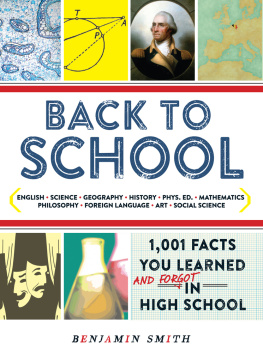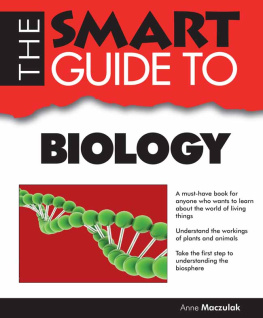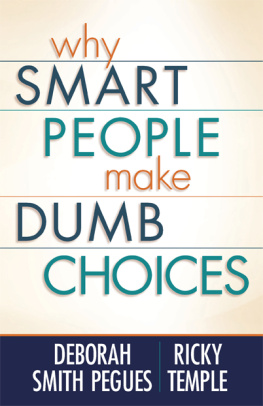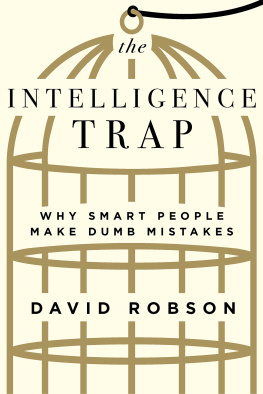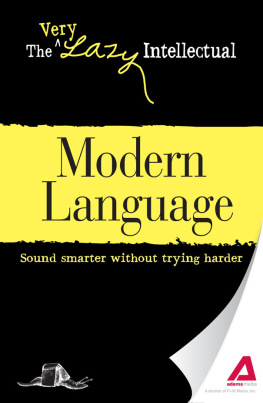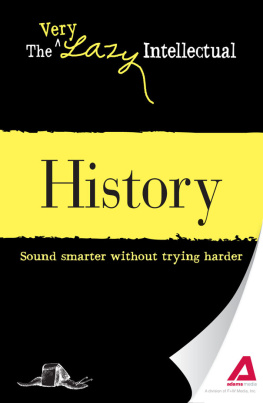Contents
Guide
BACK TO
SCHOOL
1,001 FACTS
YOU LEARNED
AND FORGOT
IN
HIGH SCHOOL
BENJAMIN SMITH

AVON, MASSACHUSETS
CLASS SCHEDULE
INTRODUCTION
ATTENTION, ALL STUDENTS. This is your principal here. Its been a long time since you walked down these halls, and sat at these tiny desks, but the time has come to get schooled once again. What happened to all of the biology, geometry, ancient history, and foreign languages that you learned here all those years ago? Thats what wed all like to know.
By re-enrolling, youre admitting that youve forgotten almost as much as you learned back in high school, but youre also admitting that some of this stuff might actually be useful to know. (If your sixteen-year-old self could only see you now.) Over the course of these lessons, well try to fill your head with as much knowledge as we can cram in there, but this time its going to stick. Sure, photosynthesis, and the Cold War, and the prepositional phrases dont come up a lot in everyday conversation, but when they do, do you want to be able to contribute to thoughtful conversation? The choice is yours.
This book gives you a chance to redo ten of your favorite courses from your high-school days without having to deal with prom queens and jocks or stoners and bullies. From geography to literature, and philosophy to phys. ed., youll learn all the most useful facts you thought were long forgotten, and maybe a few things you never knew in the first place.
Just remember a few school rules: no cheating, no gum-chewing, and no texting in class. While youre here, feel free to join some extracurriculars, but just remember to study up, because there will be a final exam. So grab your pencil and your notebook, because its time to go back to school.
The bell is about to ring, so head straight to first period, and dont be late.
PERIOD 1
ENGLISH
READING AND WRITING ARE PERHAPS THE MOST IMPORTANT SKILLS you will take from high school to adulthood. If you cant communicate properly, it will be difficult to succeed at whatever career you choose. This class will be a refresher course in proper grammar and writing skills, followed by a whistle-stop tour of English and American literature. When someone asks you your favorite book at a dinner party, this might just give you a few to choose from.
FRESHMAN YEAR: LANGUAGE ARTS
PUNCTUATION
Use of PUNCTUATION dates back to ancient Greece and Rome. Orators placed marks in their speeches to indicate where and when to pause. These marks were given names such as period, comma, and colon, correlating to the kind of pauses needed. Punctuation was used infrequently, and it was not until the fifteenth century, with the introduction and rise of printing in England, that the punctuation we know today began to be used.

A PERIOD is used at the end of a sentence to create a statement and complete a thought. A period can also be used at the end of a command, such as, When youve finished the last part of the exam, put your pencils down. A period is also used to end an indirect question, for example, Her boss asked her why she didnt come to work on Monday.

The COMMA has many uses. A comma should be used to separate any independent clause joined by the conjunctions and, yet, so, but, for, nor, and or. A comma is also used to separate items in a list or series and after an introductory adverb clause. The comma can also be used to interrupt a sentence to add extra information. For example, Her dog, which had jumped in the puddle, was soaking wet.

As a general rule you can use a SEMICOLON instead of a period to connect two sentences without a conjunction. For example, Give me your number; Ill call you when I get home. A semicolon should also be used before transitional adverbs like however, therefore, and namely. One can also use a semicolon in a series if one or more of the items includes a comma, or when two sentences are joined by a coordinating conjunction and there are commas in the first sentence.
EXTRACURRICULARS: NEWSPAPER
OXFORD COMMA SPURS CONTROVERSY
The OXFORD COMMA , also known as the serial comma or the Harvard comma, may be punctuations most controversial mark. It is used immediately before a coordinating conjunction (usually and, or, nor) in a list of items. Some reference books, like the MLA Style Manual and Guide to Scholarly Publishing and The Chicago Manual of Style demand its use, while The Associated Press Stylebook and The Canadian Press Stylebook are firmly against it. Those opposed find it redundant, and those in favor feel it resolves ambiguity.

A COLON is used if one wishes to emphasize the second of two independent clauses. For example, The time had passed: his date never showed up. A colon can also be used to introduce a list, a quotation, an appositive (in which two phrases are placed next to each other, with one serving to define or change the other), or another idea related to the independent clause.

An EM DASH is used to place emphasis on or set content apart from the rest of the text. Named because it is the width of an M, this dash is longer and places more importance on text than parentheses do. For example, A lot of people were in the crowdTom and Scott among them. The EN DASH , which is the width of an N, is shorter and is used to indicate a span of values between two numbers. For example, For ages 35.
SENTENCE COMPOSITION
Knowledge of PARTS OF SPEECH , or word classes, is critical in understanding how composition works. Parts of speech are NOUNS , (people, places, or things); PRONOUNS (words like he, she, and it used to replace nouns); ADJECTIVES (words that describe nouns); VERBS (actions); ADVERBS (words that modify adjectives, verbs, other adverbs, or an entire clause or sentence by expressing place, manner, or time); CONJUNCTIONS (words used to connect phrases or sentences such as and, but, and because); ARTICLES (words that indicate nouns and specify their application, such as a, an, and the); PREPOSITIONS (words like at, by, with, and from used to link nouns, pronouns, or phrases to other parts of the sentence); and INTERJECTIONS (words that show emotion and are capable of standing alone, like wow, or ugh.)

The three main parts of a sentence are the subject, the verb, and often, the object. The SUBJECT is usually the noun, and it is who or what the sentence is about. The VERB then follows the subject, indicating what action takes place. Lastly, the OBJECT follows the verb and is what receives the action. In the sentence Tom threw the ball to Sally,

